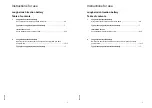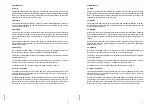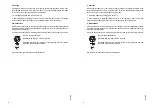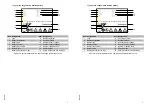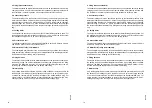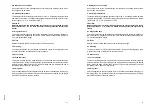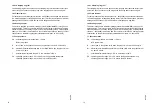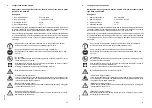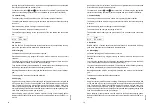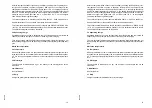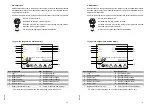
15
0506
.GB
With the charger switched off connect up the battery, ensuring that the polarity is cor-
rect (positive to positive, negative to negative). Now switch on the charger. When
charging the temperature of the battery rises by about 15° C, so charging should only
begin if the battery temperature is below 35° C. The battery temperature should be at
least +15°C before charging otherwise a full charge will not be achieved. Are the tem-
peratures a longer time higher than +40° C or lower than +15° C, so the chargers
need a temperatures regulated voltage.
The correction factor is, in accordance with DIN EN 50272-1, -0,005 V/c and Kelvin.
Special instructions for the operation of batteries in hazardous areas.
This concerns batteries which are used in accordance with EN 50 014, DIN VDE 0170
/ 0171 Ex I (in areas with a firedamp hazard) or Ex II (in potentially explosive areas).
The attention pictograms has to be respected.
2.3 Equalising charge
Equalising charges are used to safeguard the life of the battery and to maintain its
capacity. Equalising charges are carried out following normal charging.
They are necessary after deep discharges and repeated incomplete recharges. For
the equalising charges has to be used only the battery manufacturer prescribed char-
gers.
Watch the temperature!
2.4 Temperature
A battery temperature of 30°C is specified as the rated temperature. Higher tempera-
tures shorten the life of the battery, lower temperatures reduce the available capacity.
45° C is the upper temperature limit and is not acceptable as an operating tempera-
ture.
2.5 Electrolyte
The electrolyte is immobilised in a gel. The density of the electrolyte can not be
measured.
3. Maintenance
Don’t refill water!
3.1 Daily
Charge the battery immediately after every discharge.
15
0506
.GB
With the charger switched off connect up the battery, ensuring that the polarity is cor-
rect (positive to positive, negative to negative). Now switch on the charger. When
charging the temperature of the battery rises by about 15° C, so charging should only
begin if the battery temperature is below 35° C. The battery temperature should be at
least +15°C before charging otherwise a full charge will not be achieved. Are the tem-
peratures a longer time higher than +40° C or lower than +15° C, so the chargers
need a temperatures regulated voltage.
The correction factor is, in accordance with DIN EN 50272-1, -0,005 V/c and Kelvin.
Special instructions for the operation of batteries in hazardous areas.
This concerns batteries which are used in accordance with EN 50 014, DIN VDE 0170
/ 0171 Ex I (in areas with a firedamp hazard) or Ex II (in potentially explosive areas).
The attention pictograms has to be respected.
2.3 Equalising charge
Equalising charges are used to safeguard the life of the battery and to maintain its
capacity. Equalising charges are carried out following normal charging.
They are necessary after deep discharges and repeated incomplete recharges. For
the equalising charges has to be used only the battery manufacturer prescribed char-
gers.
Watch the temperature!
2.4 Temperature
A battery temperature of 30°C is specified as the rated temperature. Higher tempera-
tures shorten the life of the battery, lower temperatures reduce the available capacity.
45° C is the upper temperature limit and is not acceptable as an operating tempera-
ture.
2.5 Electrolyte
The electrolyte is immobilised in a gel. The density of the electrolyte can not be
measured.
3. Maintenance
Don’t refill water!
3.1 Daily
Charge the battery immediately after every discharge.
Summary of Contents for EME 112
Page 1: ...Operating instructions 77800386 EME 112 G 05 00 07 08 ...
Page 3: ...0108 GB 0108 GB ...
Page 7: ...0506 GB 2 0506 GB 2 ...
Page 9: ...0600 GB A 2 0600 GB A 2 ...
Page 25: ...1001 GB D 6 1001 GB D 6 ...
Page 28: ...E 3 0301 GB 5 2 1 4 3 6 7 8 9 10 E 3 0301 GB 5 2 1 4 3 6 7 8 9 10 ...
Page 35: ...0301 GB E 10 0301 GB E 10 ...
Page 47: ......
Page 65: ...0506 GB 18 0506 GB 18 ...

